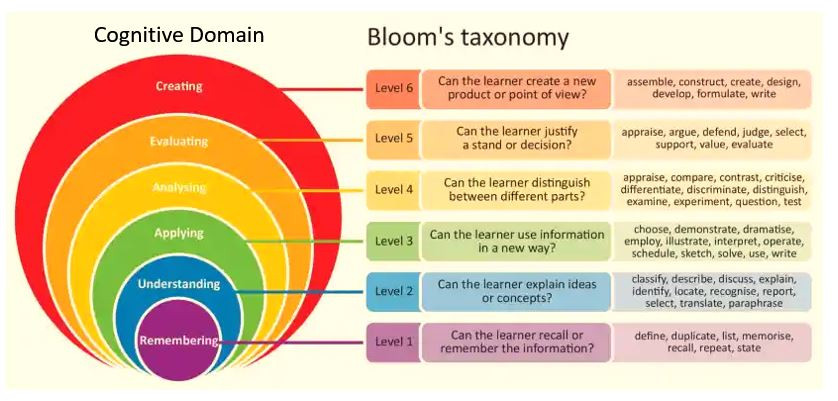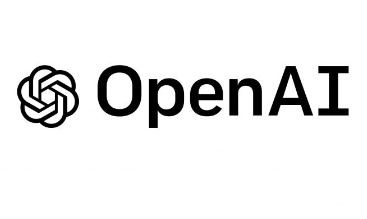布卢姆分类学 (Bloom's taxonomy)
布鲁姆教育目标分类法是一种教育的分类方法。教育目标可分为三大领域:认知领域、情感领域和动作技能领域。根据布卢姆的理论析,知识可以分成以下三个范畴[1]:
认知范畴(Cognitive Domain)
技巧范畴(Psychomotor Domain)及
态度范畴(Affective Domain)
重要的是,在分类的每个领域中定义的不同层次的思维是分层的。 换句话说,每个级别都包含它之前的级别。 因此,如果我们以认知领域为例(如图 1 所示),我们可以推断,在学生进行分析之前,他们可能首先需要了解分析方法,了解要复习的不同元素, 并考虑应用哪种方法。 只有到那时,他们才能准备好自己进行分析。
It's important to note that the different levels of thinking defined within each domain of the Taxonomy are hierarchical. In other words, each level subsumes the levels that come before it. So, if we look at the cognitive domain for example (which is represented in Figure 1), we can infer that before a student can conduct an analysis, they first might need to know the methods of analysis, understand the different elements to review and consider which method to apply. It is only then that they will be ready to conduct the analysis itself.
布卢姆分类法在 认知范畴” 的分类Cognitive Domain。(Anderson & Krathwohl, 2001)
每一范畴对应于学习的不同层次,而较高层次对应学科内较复杂的内容,亦距离对该学科的通达(Mastery,台湾译作“精熟”)的距离亦较接近。布卢姆分类学的最终目标,是要鼓励教学者对教学的三个范畴都要有所聚焦,以达至整全(holistic)的教育。
Level One、认知/记忆(Remember / Knowledge)
层次一:.知道(知识或记忆)(knowledge)
是指认识并记忆。这一层次所涉及的是具体知识或抽象知识的辨认,用一种非常接近于学生当初遇到的某种 观念和现象时的形式,回想起这种观念或现象。适合新初学者,对新课题完全没有新概念。
行动词提示:回忆recall,记忆remember,识别identify,列表list,定义define,陈述state,呈现present
Lesson Objective = Outcome 学习成果 (LO)
例如: 学员能够识别心脏病发作和心脏骤停的区别
- LO example: Able to identify the difference between heart attack and cardiac arrest
- Sample learning outcome: Remember the names and relationships of a cast of characters in a play.
- Sample of pedagogy(MOI): Self-directed learning, Group discussion, Matching, and reading
- Sample assessment/activity: A multiple-choice test designed to test the memory of learners.
- Rationale: A multiple-choice test will allow educators to see whether students have effectively memorized the given material.
Level Two 层次二: 领会、了解(Comprehension / Understanding)
是指对事物的领会,但不要求深刻的领会,而是初步的,可能是肤浅的。其包括“转化”、解释、推断等。当初学者认识了新事物或有概念后,就想深入了解他的作用与功能,培训师到这一层次,可以深一层的解释并邀请他们解答来了解他们是否理解。
行动词提示: 说明illustrate,识别identify,描述describe,解释explain,区别distinguish,重述restate,归纳summarize,比较compare
Lesson Objective = Outcome 学习成果 (LO)
例如: 学员能够解释心室颤动VF的心律失常或心律不齐,怎么样影响您心室。 心室颤动会危及生命,需要立即就医。
- LO example: able to explain the Ventricular fibrillation is a type of arrhythmia, or irregular heartbeat, that affects your heart's ventricles.
- Sample learning outcome: Understand and explain the main ideas of a play or piece of literature.
- Sample of pedagogy (MOI): Group discussion, Debate, Presentation
- Sample assessment/activity: Write a short paper summarizing the plot and the most important events in the play.
- Rationale: Writing a summary encourages learners to think about what the most important parts of a piece of literature are, and to decide which aspects of the plot to disregard in favor of a concise summary. It allows educators to evaluate whether or not they have understood the main idea of the play.
Level Three 层次三:应用 (Application)
是指对所学习的概念、法则、原理的运用。它要求在没有说明问题解决模式的情况下,学会正确地把抽象概念运用于适当的情况。这里所说的应用是初步的直接应用,而不是全面地、通过分析、综合地运用知识。
行动词提示: 应用Apply,论证demonstrate,操作 operate,实践,practice, 分类classify,举例说明illustrate,解决solve
Lesson Objective = Outcome 学习成果 (LO)
例如: 学员能够说明心肺复苏术和除颤如何使我们的心脏恢复正常的节律并可能挽救生命。
- LO example: able to illustrate how CPR and defibrillation can restore our heart to its normal rhythm and may be lifesaving.
- Sample learning outcome: Apply the main ideas/themes in the play to another context.
- Sample of pedagogy (MOI): Scenario-based learning, Practical-based and Demonstration or “Show-Me how” method
- Sample assessment/activity: Write an advice column responding to one of the characters.
- Rationale: In doing this assignment, learners will consider the implications of a character’s actions outside of the consequences shown in the play.
Level Four 层次四: 分析(analysis)
是指把材料分解成它的组成要素部分,从而使各概念间的相互关系更加明确,材料的组织结构更为清晰,详细地阐明基础理论和基本原理。当学习者了解了如何应用课题理论或方程式后,他们可以进一步的学习怎么分析问题的发生,这对学习者有更深一层的理解与应用与分析能力。
行动词提示: 分析analyse,检查examine,实验experiment,组织organize,对比contrast,比较compare,辨别distinguish 、discern,区别 differentiate
Lesson Objective = Outcome 学习成果 (LO)
例如: 学员能够辨别施救者被用力和快速推动,成人按压 4-6 厘米深,每分钟按压 100-120 次,胸部完全回缩。
- LO example Able to discern the rescuer had pushed hard and fast, compressing 4–6 cm deep for adults at 100–120 compressions per minute with complete chest recoil.
- Sample learning outcome: Be able to analyze the relative roles of each character in the play and their relationships with each other.
- Sample of pedagogy (MOI): Case-Based Problem-Based or scenario-Based learning
- Sample assessment/activity: Write an analytical paper comparing the antagonists and protagonists of the play.
- Rationale: Through this assignment, as learners consider what makes each character an antagonist or a protagonist, they need to use both their knowledge of the play and critical thinking skills.
Level Five 层次五: 评价(evaluation)
这是认知领域里教育目标的最高层次。这个层次的要求不是凭借直观的感受或观察的现象作出评判,而是理性的深刻的对事物本质的价值作出有说服力的判断,它综合内在与外在的资料、信息,作出符合客观事实的推断。
行动词提示: 评价Evaluate,估计estimate,评论comment on,鉴定authenticate,辩明justify,辩护vindicate,证明 Proof,预测forecast,预言predict,支持support
Lesson Objective = Outcome 学习成果 (LO)
例如: 学员能够评论在实际复苏过程中评估的 CPR 质量,并向施救者提供反馈,以改进他们的 CPR 技术。
- LO example: Able to comment on the quality of CPR being evaluated during actual resuscitations and feedback being provided to the responders in order to improve upon their CPR technique.
- Sample learning outcome: Evaluate the decisions of characters in the play, and support your evaluation with textual evidence.
- Sample of pedagogy (MOI): Coaching, Assessing, Evaluation an activity or test or Case-based and comments or making a report
- Sample assessment/activity: Write a response to one of the events in the play, either supporting or rejecting their actions on the basis of evidence from the play as well as personal opinion and projected/actual consequences of an action.
- Rationale: Through this assignment, learners will consider the rationale and consequences for actions in the play, leading them to understand and make judgments about the validity of a character’s decision-making.
Level Six 层次六: 创造 、 综合(Create / synthesis)
是以分析为基础,全面加工已分解的各要素,并再次把它们按要求重新地组合成整体,以便综合地创造性地解决问题。它涉及具有特色的表达,制定合理的计划和可实施的步骤,根据基本材料推出某种规律等活动。它强调特性与首创性,是高层次的要求。
行动词提示: 组成compose,建立build,设计design,开发develop,计划plan,支持support,系统化 systematize
Lesson Objective = Outcome 学习成果 (LO)
例如: 学员能够设计和制定一套提供管理复苏服务的新政策、程序、流程和协议。
- LO example: Able to design and develop new Policies, procedures, processes, and protocols that govern the provision of resuscitation services.
- Sample learning outcome: Create a new and unique piece of writing using similar plot devices.
- Sample of pedagogy (MOI): Design a new project, Project-based, Assignment, Presentation, and create a new system.
- Sample assessment/activity: Create a short story using similar plot devices in a new time or setting.
- Rationale: Through this activity, learners must integrate the plot devices and writing techniques into a new setting, allowing them to practice their creative writing skills and showing their full understanding of the writer's techniques.













No Comments